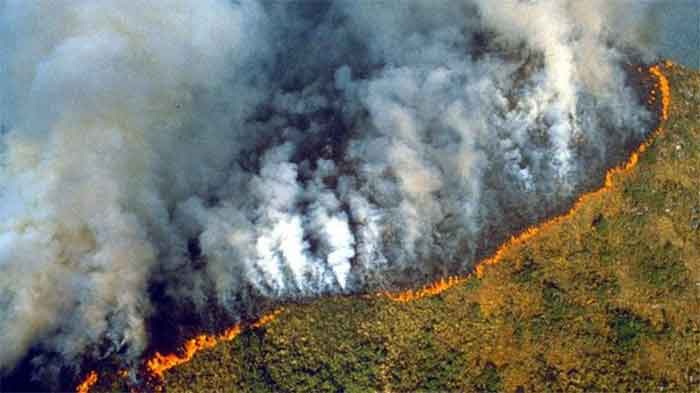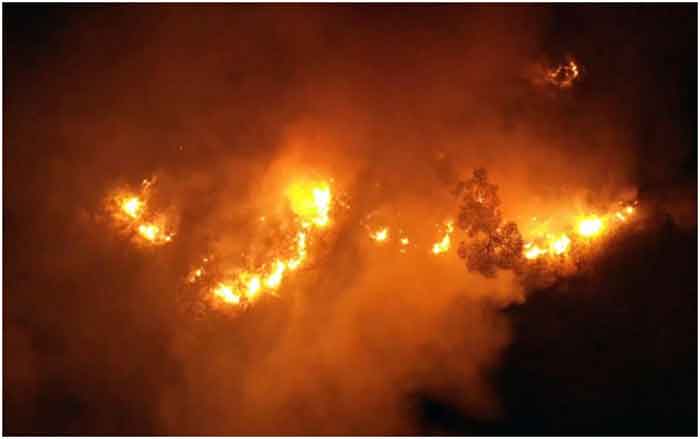
Scientists and environmental groups have expressed alarm after new data revealed there were 28 percent more fires in Brazil’s Amazon rainforest this July compared with the same time last year.
Satellite images released by INPE, Brazil’s space research agency, on Saturday revealed 6,803 fires in the Amazon last month. There were 5,318 in July 2019.
Citing official data, a Reuters report said:
The number of fires in Brazil’s Amazon rainforest jumped 28% in July from a year ago.
Some environmentalists warned a jump this week could signal a repeat of last year’s surging destruction of the world’s largest rainforest.
Brazil is home to 60 percent of the Amazon, which is the world’s largest tropical rainforest.
“I am super concerned,” Erika Berenguer, an Amazon ecologist and a senior research associate at Britain’s University of Oxford, told Sunday.
Adding that she was “alarmed by the numbers,” Berenguer said that July was the beginning of “burning season” when areas, which have been deforested have to be burned to clear the land.
“This is an indicator that the rest of the burning season is going to be very intense,” she said.
Her comments were echoed by Ane Alencar, science director at Brazil’s Amazon Environmental Research Institute (IPAM).
“It’s a terrible sign,” she told the Reuters press agency. “We can expect that August will already be a difficult month and September will be worse yet.”
After analyzing the data, Greenpeace International concluded that more than 1,000 fires were registered in the Amazon on July 30. It said this was the highest number of hotspots on a single day in July since 2005.
“We can’t continue to break such records,” the environmental organization said in a tweet.
Greenpeace has previously warned that 2020 could be even more devastating for the rainforest and the Indigenous peoples who call it home.
And a report released by IPAM last fall found that deforestation — and not drought — was the primary driver behind the record fires in 2019.
However, Brazil’s right wing President Jair Bolsonaro, a climate change skeptic, has urged for more development and economic opportunities in the Amazon region, which is often referred to as the “lungs of the planet.” However, Bolsonaro had to send the military to fight forest fires starting in May.
With pressure mounting, the U.S.-backed Bolsonaro’s government announced earlier this month that it planned to ban setting fires in the Amazon for 120 days. Greenpeace called the measure “insufficient.”
The organization shared images of what it said were fires burning in the central state of Mato Grosso despite the ban. It said the photos show smoke, flames, “and just how ineffective the ban has been.”
The greatest evidence that both of these measures were not effective is the number of fires seen in July, Berenguer said, adding that IPNE has also released data last week to show that July 2020 was already the second worst July on record for deforestation, behind July 2019.
“It’s clearly not working when we see such high deforestation rates combined with a high number of fires,” Berenguer added.
Researchers at the U.S. space agency NASA also warned earlier this month that conditions are “ripe” for an active fire season in the Amazon, saying warmer than average sea surface temperatures in the tropical North Atlantic Ocean so far in 2020 have elevated the risk of fires in the southern Amazon.
The NASA scientists said higher surface temperatures in the tropical North Atlantic Ocean in 2020 were drawing moisture away from the southern Amazon.
“As a result, the southern Amazon landscape becomes dry and flammable, making human-set fires used for agriculture and land clearing more prone to growing out of control and spreading,” NASA said on its website.
Warmer surface waters near the equator draw moisture northward and away from the southern Amazon, the space agency said, resulting in the Amazon landscape being dry and flammable. That in turn makes human-set fires used for agriculture and land clearing more prone to growing out of control and spreading, it added.
Berenguer said that this could produce a “double whammy” this year with fires able to sustain themselves even in untouched forest.
IPAM also warned in June that a deforested area of at least 4,500 square kilometers in the Amazon is ready to burn.
“This fallen vegetation on the ground can go up in smoke with the dry season that began in June in another season of intense fire like we observed in 2019,” it said in a statement.
“If this happens, the number of hospitalizations for respiratory problems can increase significantly, putting further pressure on the region’s healthcare system, which is already severely affected by COVID-19.”
Although this year’s figures is a three-year high for July, the figure pales in comparison to last year’s peak of 30,900 fires in August – a 12-year high for that month.
Environmental groups say there are worrying signs of what may come, with the final days of the month showing a sharp spike.
Environmental advocates blame right wing Bolsonaro for emboldening illegal loggers, miners and land speculators to destroy the forest with his vision of economic development for the region.
Bolsonaro has encouraged agricultural and mining activities in the Amazon. The rightist Bolsonaro defends his plans to introduce mining and farming in protected reserves as a way to lift the region out of poverty.
Bolsonaro has criticized Ibama, Brazil’s environmental enforcement agency, for what he describes as excessive fines, and his first year in office saw a sharp drop in financial penalties being imposed for environmental violations. The agency remains underfunded and understaffed.
Scientists say the rainforest is a vital defense against climate warming because it absorbs greenhouse gases.
Amazon Conservation, an environment NGO, says it has tracked 62 major fires for the year as of July 30. Many of those came after July 15, when the fire ban went into effect, indicating it has not been entirely effective, said Matt Finer, who leads the NGO’s fire tracking project.
The overwhelming majority of large fires, where elevated levels of aerosols in the smoke indicate large amounts of burning biomass, happened in recently deforested areas, with none found in virgin forest, Finer said.
Criminals generally extract valuable wood from the jungle before setting fire to the land to increase its value for farming and ranching. Natural fires are very rare in the Amazon.
Deforestation hit an 11-year high in 2019 and has soared a further 25% in the first half of 2020.
Fires in the Pantanal
Fires are also worsening in the Pantanal, the world’s largest wetlands, adjacent to the southern Amazon.
In July, the number of blazes in the Pantanal more than tripled to 1,684 compared to the same month a year ago, according to INPE data, the most for that month since records began in 1998.
SIGN UP FOR COUNTERCURRENTS DAILY NEWSLETTER












































